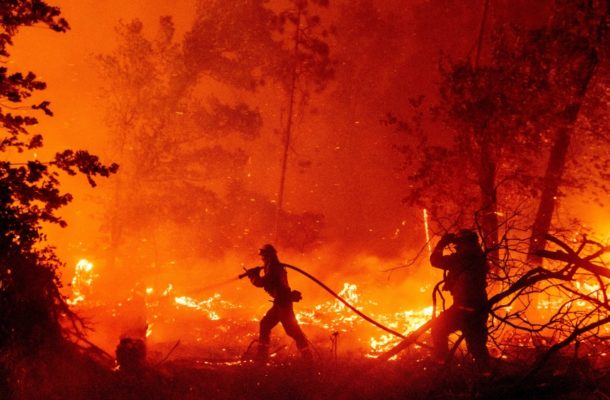Evacuation orders have been expanded to more mountain communities as a huge wildfire churns through California's Sierra National Forest on Monday, one of dozens of blazes crews battled during a heatwave that shattered records across the most populous state in the United States.
Firefighters working in steep terrain through the night saved the tiny town of Shaver Lake from flames that roared down hillsides toward a marina. To the north, about 30 houses were destroyed in the remote hamlet of Big Creek.
"About half the private homes in town burned down," Big Creek resident Toby Wait said. "Words cannot even begin to describe the devastation of this community. And it is a very close-knit community."
An elementary school, church, library, historic general store and a major hydroelectric plant were spared in the community of about 200 residents, Wait told the Fresno Bee.
Sheriff's deputies went door to door to make sure residents were complying with orders to leave. Officials hoped to keep the fire from pushing west into rural towns along State Route 41 and possibly Yosemite National Park.
![Los Angeles Fire Department firefighters work to douse brush fires in the Sepulveda Basin in the Sherman Oaks area of Los Angeles,[AP Photo/Richard Vogel] California fires](https://www.aljazeera.com/mritems/Images/2020/9/7/498e0096ccd3404895a528c816c3b578_18.jpg)
Los Angeles Fire Department firefighters work to douse brush fires in the Sepulveda Basin near the Sherman Oaks area of Los Angeles, California [Richard Vogel/AP Photo]
The blaze dubbed the Creek Fire has charred more than 295sq km (114sq miles) of timber after breaking out Friday. The 850 firefighters on the scene had yet to get any containment after three days of work in sweltering heat. There was no official tabulation yet of structures lost.
On Saturday, rescuers in military helicopters airlifted 207 people to safety after flames trapped them in a wooded camping area near Mammoth Pool Reservoir northeast of Fresno.
In Southern California, crews scrambled to douse several fires that roared to life in searing temperatures, including one that closed mountain roads in Angeles National Forest. The California Department of Forestry and Fire Protection, or Cal Fire, said a blaze in San Bernardino County called the El Dorado Fire started Saturday morning and was caused by a smoke-generating pyrotechnic device used by a couple during a "gender reveal" gathering to disclose their baby's gender.
A fire in the Angeles National Forest northeast of Los Angeles forced the evacuation of Mount Wilson Observatory.
![Smoke from wildfires burning east of Los Angeles dimming the sunrise on Monday, September 7, 2020 [P Photo/John Antczak] California fires](https://www.aljazeera.com/mritems/Images/2020/9/7/275f2af0138c4a3ca8c6f87253963b5f_18.jpg)
Smoke from wildfires burning east of Los Angeles dimming the sunrise on Monday, September 7, 2020 [Photo/John Antczak]
In eastern San Diego County, the Valley Fire broke had destroyed at least 10 structures after burning 41.44sq km (16sq miles) and prompting evacuations near the remote community of Alpine in the Cleveland National Forest.
Daytime temperatures in fire zones neared or exceeded triple digits. Downtown Los Angeles reached 44C (111F) on Sunday and a record-shattering high of 49.4C (121F) was recorded in the nearby Woodland Hills neighbourhood of the San Fernando Valley. It was the highest temperature ever recorded in Los Angeles County, according to the National Weather Service.
Meanwhile, downtown San Francisco set a record for the day with a high of 37.7C (100F) on Sunday, smashing the previous mark by five degrees.
The exceptionally hot temperatures were driving the highest power use of the year, and transmission losses because of wildfires have cut into supplies. The California Independent System Operator that manages the state's power grid warned that up to three million people could lose power Sunday if residents did not curtail their electricity usage.
At about 7pm (02:00 GMT), the agency declared an emergency and said power outages were imminent because a transmission line carrying power from Oregon to California and another in-state power plant went offline unexpectedly. But about 8:30pm, the agency issued a tweet calling off the emergency "thanks to conservation of Californians!" It said no power outages were ordered.
#ISO lifts Stage 2 emergency declaration, thanks to conservation of Californians! No outages were ordered by the grid operators #FlexAlert ends at 9 pm. #ItWorked. Again.
— California ISO (@California_ISO) September 7, 2020
The weather forecast called for more heat on Monday and the grid operators again urged people to conserve power between 3pm and 9pm, when usage is highest. Cooler temperatures were expected Tuesday but the weather change also was expected to bring winds that could fan wildfires.
Pacific Gas & Electric, the state's largest utility serving customers in Central and Northern California, warned customers that it might cut power starting Tuesday because of the increased fire danger. Some of the state's largest and deadliest fires in recent years have been sparked by downed power lines and other utility equipment. All of Northern California has moderate to severe drought conditions.
Cal Fire said 14,800 firefighters were battling 23 major fires in the state. California has seen 900 wildfires since August 15, many of them started by an intense series of thousands of lightning strikes. The blazes have burned more than 2 million acres (809371 hectares) in California this year, setting a state record.
The most striking thing about the record is how early it was set, with the most dangerous part of the year ahead, said Lynne Tolmachoff, spokeswoman for Cal Fire.
"It’s a little unnerving because September and October are historically our worst months for fires," she said. "It’s usually hot, and the fuels really dry out. And we see more of our wind events."
The previous high was 1.96 million acres (793,184 hectares) burned in 2018. Cal Fire began tracking the numbers in 1987.Source: aljazeera.com


Comments